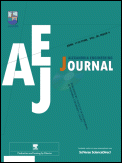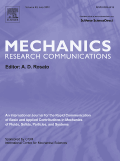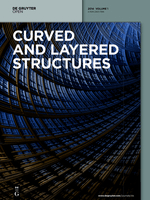
Applications in Engineering Science
Scope & Guideline
Bridging Disciplines for Engineering Excellence
Introduction
Aims and Scopes
- Fluid Mechanics and Rheology:
Research on the behavior of fluids, including non-Newtonian fluids, viscoplastic materials, and their modeling using advanced computational techniques like finite element methods and CFD. - Material Science and Engineering:
Studies on the properties and applications of new materials, including composites, nanomaterials, and sustainable materials, focusing on their mechanical behavior and structural applications. - Structural Engineering:
Investigations into the stability, behavior, and optimization of structures, including concrete, steel, and hybrid materials, under various loading conditions. - Energy Systems and Sustainability:
Research related to energy efficiency, renewable energy systems, and sustainable engineering practices, including innovative designs for energy harvesting and waste management. - Mathematical Modeling and Simulation:
Development and application of mathematical models to simulate physical phenomena in engineering contexts, including dynamic systems, heat transfer, and fluid-structure interactions. - Computational Mechanics:
Exploration of computational techniques for solving complex engineering problems, including finite element analysis, machine learning applications in engineering, and hybrid modeling approaches.
Trending and Emerging
- Nano-Engineering and Material Modification:
There is a growing focus on the incorporation of nanomaterials and modifications to enhance the properties of traditional materials, especially in concrete and composites, indicating a trend towards more sustainable and high-performance materials. - Sustainable Engineering Practices:
Research emphasizing sustainability, including the use of recycled materials and energy-efficient designs, is increasingly prevalent, highlighting a global shift towards environmentally friendly engineering solutions. - Advanced Computational Techniques:
The integration of machine learning and artificial intelligence in engineering applications is on the rise, showcasing a trend towards more data-driven and adaptive approaches in modeling and simulations. - Complex Fluid Dynamics and Viscoplasticity:
An increase in studies addressing the complexities of fluid dynamics in non-Newtonian and viscoplastic materials reflects a growing interest in understanding these challenging behaviors for industrial applications. - Interdisciplinary Approaches to Engineering Problems:
There is a marked trend towards interdisciplinary research that combines insights from various engineering domains, such as bioengineering, materials science, and environmental engineering, to tackle complex challenges.
Declining or Waning
- Traditional Mechanical Systems:
Research focused on purely classical mechanical systems and components, such as basic mechanisms and traditional material testing, has seen a decline as more complex and interdisciplinary approaches gain traction. - Basic Fluid Dynamics:
Studies that concentrate solely on fundamental fluid dynamics principles without integration of advanced computational methods or applications in real-world scenarios have become less frequent. - Conventional Structural Analysis Techniques:
There is a noticeable reduction in papers employing standard analytical methods for structural analysis, as newer computational methods and simulations are preferred for their efficiency and accuracy. - Static Analysis of Materials:
The exploration of static properties of materials, without consideration of dynamic or time-dependent behaviors, has decreased, reflecting a broader interest in dynamic responses and real-time applications. - Single-Disciplinary Studies:
Research that does not integrate multiple engineering disciplines or interdisciplinary approaches is becoming less common, as the field increasingly values collaborative and multifaceted research efforts.
Similar Journals

Alexandria Engineering Journal
Elevating engineering practices with premier research.Alexandria Engineering Journal is a premier open access publication dedicated to advancing the field of engineering. Published by ELSEVIER and headquartered in Amsterdam, the Netherlands, this journal has been at the forefront of disseminating innovative research since its inception in the year 2000. With its impressive Q1 ranking within the Engineering (miscellaneous) category and a notable position as #20 out of 307 in the Scopus rankings, it serves as a vital resource for scholars and practitioners alike, ensuring that cutting-edge findings reach a global audience. The journal is accessible to all since adopting open access policies in 2010, thereby facilitating the sharing of valuable insights without barriers. As we approach the convergence of years from 2000 to 2024, the Alexandria Engineering Journal continues to play a pivotal role in shaping engineering practices and underpinning significant advancements in the field.

International Journal of Engineering Research in Africa
Fostering Knowledge, Driving ProgressThe International Journal of Engineering Research in Africa is a pivotal academic resource for researchers, professionals, and students interested in the multifaceted field of engineering within the African context. Published by TRANS TECH PUBLICATIONS LTD, this journal facilitates the dissemination of innovative research, covering a myriad of topics in engineering, from advanced materials to sustainable practices. With an ISSN of 1663-3571 and E-ISSN 1663-4144, this publication not only fosters scholarly communication but also contributes to the global engineering discourse, as evidenced by its current Q3 ranking in the Engineering (miscellaneous) category in 2023. Operating from its base in Switzerland, the journal has been actively publishing since 2010 and continues to play a vital role in the advancement of engineering knowledge, particularly in the African landscape. Although it does not offer an open access model, the journal's commitment to quality research ensures that it remains a valuable asset for those seeking to understand and innovate within the engineering sector. Its integration in Scopus with a rank of #175 out of 307 in General Engineering further underscores its relevance and impact in the engineering community.

Proceedings of the Institution of Civil Engineers-Engineering and Computational Mechanics
Bridging Theory and Practice in Engineering ExcellenceProceedings of the Institution of Civil Engineers - Engineering and Computational Mechanics is a prestigious journal published by Emerald Group Publishing Ltd, dedicated to advancing the fields of civil and structural engineering, as well as mechanics of materials. With an ISSN of 1755-0777 and E-ISSN 1755-0785, this journal serves as a critical platform for disseminating innovative research and practical insights from 2009 through 2024. As part of its commitment to academic rigor, it is categorized in the Q4 quartile for both civil and structural engineering and mechanics of materials, reflecting a unique position in the scholarly community. The journal is essential for professionals, researchers, and students aiming to stay informed on current trends, methodologies, and applications in engineering and computational mechanics. By engaging with this publication, readers gain access to crucial findings that contribute to the advancement of infrastructure and materials science, vital for developing resilient and sustainable engineering solutions.

MECHANICS RESEARCH COMMUNICATIONS
Fostering Collaboration in Advanced Engineering StudiesMECHANICS RESEARCH COMMUNICATIONS, published by PERGAMON-ELSEVIER SCIENCE LTD, is a prestigious journal in the fields of Civil and Structural Engineering, Condensed Matter Physics, Materials Science, and Mechanical Engineering. With an ISSN of 0093-6413 and E-ISSN of 1873-3972, it has made significant contributions to the understanding and advancement of mechanics and materials since its inception in 1974. The journal is well-regarded in academia, holding a Q2 ranking across multiple categories as of 2023, and ranking in the 65th percentile for Mechanical Engineering. Researchers and professionals benefit from its peer-reviewed content, which includes a wide range of articles from fundamental research to applied technological developments. Although currently not an open access journal, it remains a vital resource for those focused on innovating within the engineering and materials science domains. With its established legacy, MECHANICS RESEARCH COMMUNICATIONS continues to shape the discourse in mechanics and engineering, making it essential reading for students and practitioners alike.

MECHANICS OF ADVANCED MATERIALS AND STRUCTURES
Elevating research in mechanics with cutting-edge discoveries.Mechanics of Advanced Materials and Structures is a distinguished journal published by Taylor & Francis Inc, focusing on the innovative fields of Civil and Structural Engineering, Materials Science, Mechanical Engineering, and Mechanics of Materials. With ISSN 1537-6494 and E-ISSN 1537-6532, this journal is positioned within the Q2 quartile rankings of its categories, demonstrating its significant scholarly impact. It has been a pivotal platform since its inception in 1997, providing researchers and professionals with comprehensive insights and the latest findings, until the expected closure in 2024. Situated in the United Kingdom, the journal is dedicated to enhancing the understanding of complex materials and structural behavior through rigorous peer-reviewed articles. Its high visibility in Scopus rankings further underscores its importance, making it an essential resource for those engaged in advanced materials research and structural analysis. With options for open access, the journal ensures broad dissemination of knowledge, fostering a collaborative environment for researchers, practitioners, and students alike.

Modelling and Simulation in Engineering
Catalyzing Innovation in Engineering and Computer ScienceModelling and Simulation in Engineering is a pioneering open-access journal, published by HINDAWI LTD, and established in 2007. With a focus on advancing the fields of engineering, computer science applications, and modeling and simulation, this esteemed journal serves as a vital platform for researchers, professionals, and students alike. The journal has made significant strides in its academic contributions, reflected in its current categorization within the Q3 quartile in Computer Science Applications, Engineering (miscellaneous), and Modeling and Simulation as of 2023. With a Scopus ranking of 133 out of 307 in General Engineering and 183 out of 324 in Mathematics' Modeling and Simulation, it emphasizes the crucial interplay between theoretical research and practical applications. Each article published in Modelling and Simulation in Engineering undergoes a rigorous peer-review process, ensuring high-quality research dissemination. By maintaining an open-access format, the journal promotes global collaboration and accessibility, supporting the dissemination and advancement of engineering knowledge worldwide. With its headquarters located in the United States, the journal is truly positioned at the convergence of innovation and research.

Computational Thermal Sciences
Unlocking New Insights in Computational Thermal DynamicsComputational Thermal Sciences, an esteemed journal published by BEGELL HOUSE INC, presents cutting-edge research at the intersection of computational mathematics, energy engineering, and fluid dynamics. With an ISSN of 1940-2503 and an E-ISSN of 1940-2554, this journal aims to disseminate high-quality research articles, reviews, and methodologies that improve our understanding of thermal processes and their applications. Renowned for its solid impact in the field, it holds a Q3 ranking in multiple categories including Computational Mathematics and Energy Engineering for 2023. As the field evolves, the journal continues to play a pivotal role in bridging theoretical research with practical innovations, thereby catering to a diverse audience of researchers, professionals, and students. Although it operates on a subscription model, the journal ensures accessibility to significant contributions in thermal sciences from 2009 to 2024, fostering an environment of knowledge sharing and collaboration.

Journal of Applied Mechanics and Technical Physics
Unveiling Breakthroughs in Mechanics and Material ScienceJournal of Applied Mechanics and Technical Physics is a distinguished publication that serves as a vital resource for researchers and professionals in the realms of mechanical engineering, mechanics of materials, and condensed matter physics. Published by MAIK NAUKA/INTERPERIODICA/SPRINGER, this journal has been committed to disseminating high-quality research since its inception in 1965. With a noted presence in the academic community, it holds a respectable Q3 ranking in multiple categories as of 2023, indicating its relevance and contribution to the field. Although it does not currently offer open access, the journal provides valuable insights and advancements through its rigorous peer-review process. Covering a broad spectrum of topics in applied mechanics and technical physics, it aims to foster innovation and dialogue among scientists, engineers, and scholars alike. Located in the United States, the journal continues to make significant strides in bridging the gap between theoretical research and practical applications, making it an essential read for anyone engaged in these dynamic fields.

World Journal of Engineering
Bridging Theory and Practice in Engineering AdvancesWorld Journal of Engineering, published by EMERALD GROUP PUBLISHING LTD, stands as a premier platform for disseminating high-quality research across various engineering disciplines. Since its inception in 2014, the journal has built a reputation for its rigorous peer-review process and commitment to advancing knowledge in the fields of Civil and Structural Engineering, Electrical and Electronic Engineering, Geotechnical Engineering, Mechanical Engineering, and Mechanics of Materials. With its categorization in the Q3 quartile across multiple engineering domains and notable Scopus rankings, the journal positions itself as a valuable resource for researchers, professionals, and students seeking to stay abreast of innovations and critical developments in engineering. While the journal currently operates under a subscription model, its comprehensive scope ensures that it remains a vital reference point for contemporary engineering challenges and solutions throughout the United Kingdom and beyond.

Curved and Layered Structures
Transforming Ideas into Architectural MasterpiecesCurved and Layered Structures, published by DE GRUYTER POLAND SP Z O O, is a distinguished open-access journal that has been an essential platform since 2014 for academics and professionals in the fields of Aerospace Engineering, Architecture, Building and Construction, Civil and Structural Engineering, and Computational Mechanics. With an ISSN of 2353-7396, it is recognized for its impactful contributions, reflected in its impressive category quartiles, particularly Q1 in Architecture and notable rankings in various engineering disciplines. The journal's scope encompasses innovative research focusing on the intricate designs and applications of curved and layered structures, making it pivotal for advancing knowledge in these areas. The open-access format ensures widespread dissemination of research findings, promoting accessibility and collaboration among researchers and practitioners worldwide. As it navigates its converged years from 2014 to 2024, Curved and Layered Structures continues to attract high-quality submissions that push the boundaries of engineering and architectural design.